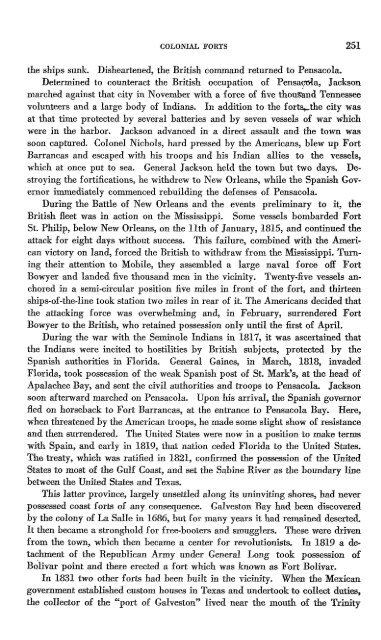THE COAST ARTILLERY JOURNAL - Air Defense Artillery
THE COAST ARTILLERY JOURNAL - Air Defense Artillery
THE COAST ARTILLERY JOURNAL - Air Defense Artillery
Create successful ePaper yourself
Turn your PDF publications into a flip-book with our unique Google optimized e-Paper software.
COLONIAL FORTS 251<br />
the ships sunk. Disheartened, the British command returned to Pensacola.<br />
Determined to counteract the British occupation of Pensa~a, Jackson<br />
marched against that city in November with a force of five thousand Tennessee<br />
volunteers and a large body of Indians. In addition to the forts.,...thecity was<br />
at that time protected by several batteries and by seven vessels of war which<br />
were in the harbor. Jackson advanced in a direct assault and the town was<br />
soon captured. Colonel Nichols, hard pressed by the Americans, blew up Fort<br />
Barrancas and escaped with his troops and his Indian allies to the vessels,<br />
which at once put to sea. General Jackson held the town but two days. Destroying<br />
the fortifications, he withdrew to New Orleans, while the Spanish Governor<br />
immediately commenced rebuilding the defenses of Pensacola.<br />
During the Battle of New Orleans and the events preliminary to it, the<br />
British fleet was in action on the Mississippi. Some vessels bombarded Fort<br />
St. Philip, below New Orleans, on the 11th of January, 1815, and continued the<br />
attack for eight days without success. This failure, combined with the American<br />
victory on land, forced the British to withdraw from the Mississippi. Turning<br />
their attention to Mobile, they assembled a large naval force off Fort<br />
Bowyer and landed five thousand men in the vicinity. Twenty-five vessels anchored<br />
in a semi-circular position five miles in front of the fort, and thirteen<br />
ships-of-the-line took station two miles in rear of it. The Americans decided that<br />
the attacking force was overwhelming and, in February, surrendered Fort<br />
Bowyer to the British, who retained possession only until the first of April.<br />
During the war with the Seminole Indians in 1817, it was ascertained that<br />
the Indians were incited to hostilities by British subjects, protected by the<br />
Spanish authorities in Florida. General Gaines, in March, 1818, invaded<br />
Florida, took possession of the weak Spanish post of St. Mark's, at the head of<br />
Apalachee Bay, and sent the civil authorities and troops to Pensacola. Jackson<br />
soon afterward marched on Pensacola. Upon his arrival, the Spanish governor<br />
fled on horseback to Fort Barrancas, at the entrance to Pensacola Bay. Here,<br />
when threatened by the American troops, he made some slight show of resistance<br />
and then surrendered. The United States were now in a position to make terms<br />
with Spain, and early in 1819, that nation ceded Florida to the United States.<br />
The treaty, which was ratified in 1821, confirmed the possession of the United<br />
States to most of the Gulf Coast, and set the Sabine River as the boundary line<br />
between the United States and Texas.<br />
This latter province, largely unsettled along its uninviting shores, had never<br />
possessed coast forts of any consequence. Galveston Bay had been discovered<br />
by the colony of La Salle in 1686, but for many years it had remained deserted.<br />
It then became a stronghold for free-booters and smugglers. These were driven<br />
from the town, which then became a center for revolutionists. In 1819 a detaclunent<br />
of the Republican Army under General Long took possession of<br />
B~livar point and there erected a fort which was known as Fort Bolivar.<br />
In 1831 two other forts had been built in the vicinity. When the Mexican<br />
government established custom houses in Texas and undertook to collect duties,<br />
the collector of the "port of Galveston" lived near the mouth of the Trinity
















